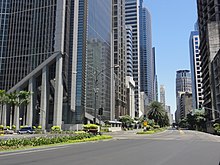Makati has a population of 582,602 as of the 2015 census.[3] Makati ranks ninth in population size within Metro Manilamunicipalities. 88.9% of Makati residents identified their religious affiliation as Roman Catholic.[citation needed] Other groups having large number of members in the city are The Church of Jesus Christ of Latter-day Saints, Ang Dating Daan, Iglesia ni Cristo, Protestantism, Islam, Hinduism, Buddhism and Judaism.[18]
Based on the city’s Transport and Traffic Improvement Plan 2004-2014, the city’s daytime population is estimated to be 3.7 million during weekdays, owing to the large number of people who come to work, do business, or shop.[19]
The daily influx of people into the city provides the skilled labor force that allows Makati to handle the service requirements of domestic as well as international transactions; it also serves as the base of a large consumer market that fuels the retail and service trade in the city.[19] At the same time, however, the large tidal population flows exert pressure on Makati's environment, services, and utilities, most noticeably causing large traffic volumes along the major road corridors leading to the city as well as within and at the periphery of the central business district.[19]
Economy and infrastructure[edit]
See also: Makati Central Business District
The city of Makati remains the richest local government unit (LGU) in the Philippines in terms of income from local sources and on a per capita basis.[20] As of end-2012, Makati had registered over 62,000 business enterprises, which are engaged in financial services, wholesale/retail, services, real estate, export/import, and manufacturing. Makati also boasts of having the highest number of BPO offices in Metro Manila at 1,159 companies to date, as well as the highest number of PEZA-accredited IT Parks and Buildings. The city government of Makati has not increased its tax rates since its new Revenue Code took effect in 2006. For 26 years now, the city enjoys a deficit-free status.[20]
The city is known for its developed business district called the Makati Central Business District (CBD). It is bound by EDSA, Gil Puyat Avenue, Arnaiz Avenue and Chino Roces Avenue. It mainly encompasses Legazpi Village, Salcedo Village, the Ayala Center, and parts ofBel-Air Village.
The Ayala Triangle is a sub-district of the Makati CBD, comprising the parcel of land between Ayala Avenue, Makati Avenue and Paseo de Roxas, as well as the buildings on those streets. Many multinational companies, banks and other major businesses are located within the triangle. A few upscale boutiques, restaurants and a park called Ayala Triangle Gardens are also located in the area.[21] Ayala Avenue and Paseo de Roxas also house the distinction of being the runways of the former Nielson Field, Metro Manila's main airport in the 1930s.
The biggest trading floor of the Philippine Stock Exchange is housed in Ayala Tower One and at the old Makati Stock Exchange Building, both along Ayala Avenue.
The Makati Business Clubis composed of over 800 chief executive officers and senior executives representing almost 450 of the largest and most dynamic corporations in the Philippines.[citation needed]
Most of the tallest skyscrapers in Metro Manila and the Philippines are located in Makati such as the PBCom Tower, Gramercy Residences in Century City and G.T. International Tower.
PBCom Tower along Ayala Avenue is the country's tallest building, reaching up 259 meters. It is the headquarters of the Philippine Bank of Communications, or PBCom. The PBCom Tower is an office skyscraper ranked officially as the tallest building in the Philippines since 2001. It has a total ground to architectural top height of 259 meters (850 ft), with 52 stories[22] including an 8-level radio tower.



No comments:
Post a Comment